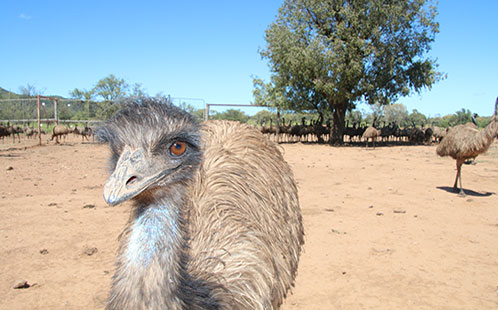Flight or fright: what future for the emus of east coast Australia?

Scientists at Western Sydney University and University of Tasmania have mapped the historic shifts in the distribution of Australia’s iconic emus (Dromaius novehollandiae), to project how regional emu populations are likely to change in the next 50 years.
Researchers used a range of cutting-edge analysis tools to determine what the future looks like for Australia’s emu populations.
The results of the analysis, published in Nature Scientific Reports (opens in a new window), show how past climatic changes over the last 6,000 years led emus to expand their populations northward, across central Australia, as well as reduce their range east of the Great Dividing Range (GDR).
Remnant emu populations are right at the limit of their climatic suitability as the changes in rainfall patterns and threats from predation, habitat loss and other causes is putting pressure on these populations...
Julia Ryeland, PhD candidate within the Hawkesbury Institute for the Environment at Western Sydney University and lead author on the study, said climate change is in large part responsible for the historic changes in the range of populations the findings – indicating that the future for east coast emu populations is potentially fragile.
“Changes in rainfall patterns over the last several thousand years have significantly reduced their distribution that were once widespread east of the Great Dividing Range, leaving remnant niche populations on the eastern coast of Australia. This makes the east coast population susceptible to potential threats such as further habitat fragmentation and predation by feral pests,” said Ms Ryeland.
“On the eastern coast, the remnant emu populations are right at the limit of their climatic suitability as the changes in rainfall patterns and threats from predation, habitat loss and other causes is putting pressure on these populations.”
Emu populations are projected to remain stable overall into the future under climate change scenarios, but east of the ranges, populations are likely to be further threatened by increasing urbanisation, and increasing losses from feral predators.
According to Associate Professor Ricky Spencer from the School of Science at Western Sydney University, who also contributed to the study, the population in north-eastern Australia is listed as endangered, and this is where efforts to conserve the remaining emu population is of paramount importance.
“The impacts on east-coast emu communities since European settlement have been dramatic, with much fewer emu populations east of the ranges. With targeted efforts to increase our knowledge of at-risk populations, we can continue to monitor population changes and ensure their long-term success,” said Associate Professor Spencer.
ENDS
14 January 2021
David Thompson
Research Media and Communications Officer
0429 951 552